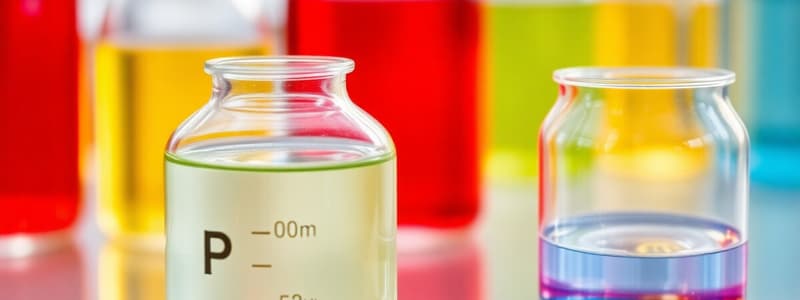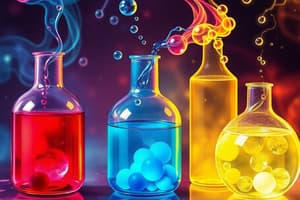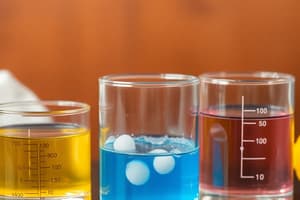Podcast
Questions and Answers
What type of ions do acids produce in water?
What type of ions do acids produce in water?
- Cl- ions
- OH- ions
- Na+ ions
- H+ ions (correct)
Sulfuric acid produces chlorides when it neutralizes an alkali.
Sulfuric acid produces chlorides when it neutralizes an alkali.
False (B)
What is the result of the neutralization reaction of an acid with an alkali?
What is the result of the neutralization reaction of an acid with an alkali?
salt and water
Hydrochloric acid produces __________ when neutralized with a metal.
Hydrochloric acid produces __________ when neutralized with a metal.
Match the acid with the type of salt it produces:
Match the acid with the type of salt it produces:
What is produced when zinc reacts with sulfuric acid?
What is produced when zinc reacts with sulfuric acid?
Metal oxides and hydroxides react with acids to form salts and gases.
Metal oxides and hydroxides react with acids to form salts and gases.
What is the main purpose of a titration?
What is the main purpose of a titration?
In a reaction between copper oxide and hydrochloric acid, the product formed is __________.
In a reaction between copper oxide and hydrochloric acid, the product formed is __________.
Match the following substances with their reaction products:
Match the following substances with their reaction products:
Which of the following acids completely ionises in water?
Which of the following acids completely ionises in water?
A pH of 7 indicates an acidic solution.
A pH of 7 indicates an acidic solution.
What happens to the hydrogen ion concentration of a solution when the pH decreases by one unit?
What happens to the hydrogen ion concentration of a solution when the pH decreases by one unit?
The pH scale ranges from _____ to _____ for measuring acidity and alkalinity.
The pH scale ranges from _____ to _____ for measuring acidity and alkalinity.
Match the following acids with their classification:
Match the following acids with their classification:
Flashcards are hidden until you start studying
Study Notes
Acids
- Acids form Hydrogen ions (H+) in water
- They react with metal carbonates to produce salt, water, and carbon dioxide
- They react with metal oxides and hydroxides to form salt and water
- They react with insoluble bases to form soluble salts, e.g. reacting copper oxide with hydrochloric acid forms copper chloride
- Strong acids completely ionise in water, e.g. hydrochloric acid, nitric acid, and sulfuric acid.
- Weak acids only partially ionise in water, e.g. ethanoic acid
- The strength of an acid is different from concentration:
- Strength: How much it ionises in water
- Concentration: How much acid is present
- The pH scale measures acidity (ranges from 0-14).
- pH 0 is very acidic, pH 7 is neutral, and pH 14 is very alkaline.
- A decrease in pH by one unit indicates a 10 times increase in hydrogen ion concentration.
Alkalis
- Alkalis form Hydroxide ions (OH-) in water
- They react with acids to form a salt and water, this reaction is called neutralisation.
- The ionic equation of neutralisation is H+ + OH- → H2O
Neutralisation
- It's the reaction between an acid and an alkali to form a salt and water
- It can be demonstrated by titration, which involves:
- Using an indicator (e.g. phenolphthalein or litmus) to determine the endpoint of the reaction
- Repeating titrations for accuracy
- Neutralisation is crucial for many industrial processes and biological systems.
Other Reactions
- Acids react with metals to produce salt and hydrogen gas
- This is a redox reaction:
- The metal is oxidised (loses electrons)
- The hydrogen ions in the acid are reduced (gain electrons)
Universal Indicator
- Helps determine the pH of a solution
- Changes colour based on the acidity or alkalinity
- It's also available as a pH probe for digital measurements.
Studying That Suits You
Use AI to generate personalized quizzes and flashcards to suit your learning preferences.




